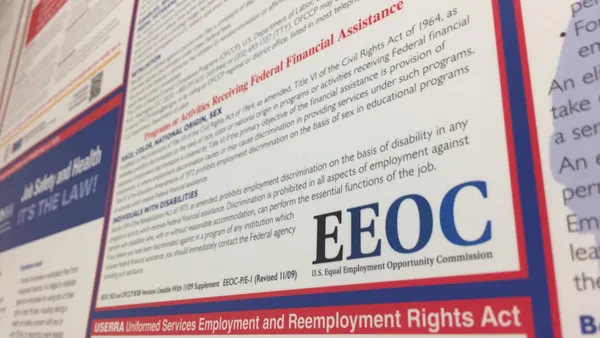Dive Brief:
- California Gov. Gavin Newsom signed SB-1383 into law Sept. 17, a move which attorneys at Jackson Lewis said "significantly expands employee entitlement to family and medical leave." Newsom’s office estimated that nearly six million additional workers in the state now have access to job-protected leave.
- The law requires that employers of five or more employees grant up to 12 weeks of unpaid, job-protected leave during any 12-month period for the purposes of: bonding with a new child and taking care for themselves or "a child, parent, grandparent, grandchild, sibling, spouse, or domestic partner, as specified." The provision represents an expansion of both eligibility and the reasons for which an employee can take leave, the Jackson Lewis attorneys said.
- The bill defines an employee as someone who has "at least 1,250 hours of service" with the employer during the past year, and also protects leave for "a qualifying exigency related to the covered active duty or call to covered active duty of an employee’s spouse, domestic partner, child, or parent in the Armed Forces of the United States." The law takes effect Jan. 1, 2021.
Dive Insight:
Even before COVID-19, leave had emerged as an area of interest for HR leaders in charge of benefits and compliance. Improving this element of compensation was gaining interest from executive leadership as well.
In December of 2019, a group of CEOs urged lawmakers to mandate paid family leave for more American workers, pointing out that a nationwide law would help employers "challenged by the growing patchwork of competing and inconsistent state plans."
During the pandemic, leave has become a growing issue. At first, employers had concerns around employees not wanting to come to work, sick individuals coming in to work, leave to take care of family and whether that leave should be paid and protected. Federal measures such as the Paycheck Protection Program were meant to help employers while the Families First Coronavirus Care and Recovery Act and emergency welfare benefits were meant to support workers.
As workplaces slowly began to reopen, a new set of challenges emerged amid the mid-pandemic "new normal." Working parents, especially, were pressed for time. In response, employers implemented flexible work policies, childcare reimbursement, and extra time off for parents and others who may have increased responsibilities outside of work as a result of the pandemic.
Ultimately, experts said they expect the pandemic to have a significant impact on employment policy, with expanded policies for leave and remote work among the key changes predicted. One attorney went as far as to call paid leave laws "probably the most significant development in HR in the last 12 months." The passage of California’s leave law, along with a recent assembly bill that included guidance on leave relating to imminent hazards, are examples of this shift.













